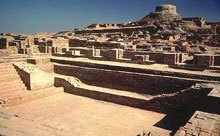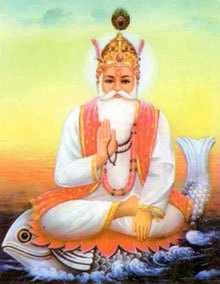Zooming The Distinct Culture of Sindhi Hindus
The Sindhis celebrate "Cheti-Chand" as the birth anniversary of Lord Jhulelal & consider it as a their New Year. Its the distinctively auspicious day among Sindhi Community through out world. The first day of the Sindhi New Year or Chetia Chandu was on Chaytu 1, 1370 Sindhu Samwat (March 21, 1997).
The Sindhis celebrate “Cheti-Chand” as the birth anniversary of Lord Jhulelal & consider it as a their New Year. Its the distinctively auspicious day among Sindhi Community through out world. The first day of the Sindhi New Year or Chetia Chandu was on Chaytu 1, 1370 Sindhu Samwat (March 21, 1997).
The first month of the year is CHAITRA, which is the first month of the lunar- based Sindhi calendar year. it is called ‘CHET’. Hence it is known as CHET (the first month of the year)-I-CHAND (first moon of the year).
Celebration & Folk Dances
 Typical cultural celebrations in the evening include BAHRANO,Chejj & Dhamaal. Baharano (with ghunghroos) where the performers also sing Jhule Lal songs.
Typical cultural celebrations in the evening include BAHRANO,Chejj & Dhamaal. Baharano (with ghunghroos) where the performers also sing Jhule Lal songs.
The second type of folk dance is CHEJJ which is a group dance & is performed only by men. It resembles Garba dance of Gujrat, the difference in chej is that one dancer, can dance with all other dancers and that too in different positions like seating or laying on the ground. Sharnai and the Dudul i.e. Shehnai and the drum are the instruments
DHAMAL is performed only by men. Dhamaal consists of very fast tempo. Nagharo (a big drum) is used in providing rhythematic beats in Dhamaal.
The prayers include Akho i.e. lighting Diyas (earthenware lamps) and these earthen lamps are set afloating in water. Dhodho (nan from jowar or buckwheat) and mint chutney is the Prasad (food offering) is distributed. This may be followed by a pot luck vegetarian dinner.
Story of Sindhi Origin
 After the Independence in 1947 Sindh become part of Pakistan and presently is the second largest provision with Karachi being the capital city. Sindh country is larger than England(area wise) in the lower Indus basin with Arabian sea Indian ocean in south, Plains of Punjab in north, desert extended to merge with Thar desert of Rajasthan in east and Khirtar mountain range in the west. Mahoan-jo-daro(civilization) vouches for Sindhi culture.
After the Independence in 1947 Sindh become part of Pakistan and presently is the second largest provision with Karachi being the capital city. Sindh country is larger than England(area wise) in the lower Indus basin with Arabian sea Indian ocean in south, Plains of Punjab in north, desert extended to merge with Thar desert of Rajasthan in east and Khirtar mountain range in the west. Mahoan-jo-daro(civilization) vouches for Sindhi culture.
It is a historic fact that Islam was promoted forcefully on the land of Sindh and Hindus were saved by Lord Jhulelal. The names “Hind” and “Hindu” have origin with “Sindh” and “Sindhu”. After the partition in the year 1947 Sindhis along with Punjabis were forced to migrate to India. So Sindhi Culture has roots in Sindh (Pakistan).
Sindhi Language: Developed by Narayan Jagannath Mehta, the Deputy Educational Inspector in Sindh, and is based mainly on the old Khudawadi script, (which was used in Hyderabad), the language is officially known the ‘Hindi Sindhi’ or ‘Hindu Sindhi’ and was used in education and literature. Arabic script replaced it gradually.2,820,485 Indians speak Sindhi Language.
Sindhi language is one among the Indo-European language with a close resemblance with Arabic in script of writing [with 52 alphabets, written from right to left] and Sanskrit, Urdu and Hindi in spoken styles.
After the independence from the British rule there was a fuss over the script used in Sindhi Language in India. At present for Sindhi language Arabic and Devnagiri scripts are used.
Commonly spoken Sindhi is “Vicholi” dialect; other five dominating dialects of spoken Sindhi language are Siraiki, Lari, Lasi, Thari or Thareli and Kachhi.
Sindhi speaking population has the majority of population is with Sind [Pakistan], Maharashtra, Gujarat, Rajasthan, Madhya Pradesh and the Union Territory of Delhi [India], Hong Kong, Singapore, Japan, the Gulf countries [Asia region] beside that various cities in America, Australia, UK and South Africa also have considerable population of Sindhi speakers.
About Lord Jhulelal
Jeko chavando jhule laal tehenjaa thindaa Beraa paar. Beraa par, sadaa bahaar.
Means “Lord Jhulelal always fulfills wishes of the devotees who worship him and request for the boon”.
Jhulelal’ is the Patron Saint of the Sindhis.
His story is based on some historical events. It’s a blend of myth & Folklores. What is important to know is that He circulated the Unity of religions and Mankind.
He was born on this day in 1007 A. D. to simple parents in Nasarpur. Jhulelal was born during turbulent times on the New Moon of Month Chaitra 1007 AD During the 10th century. The Divine child was born on ‘Cheti Chand’ to Devaki and Rattanchand of Nasarpur.
An astrologer of Nasarpur called the child ‘Amarlal’ and said that his memory would be immortal as his name suggested. Once while the child lay on his cradle, it started to swing of its own accord, hence the child was also called ‘Julelal’ which means one who swings to and fro. He often traveled on a palla-fish and is therefore portrayed sitting on a fish.
Upon opening the baby’s mouth, the parents ‘saw’ the River Sindhu flowing, and an old man with a white beard sitting on a ‘pala’ fish, which swims against the tide. Thus Jhulelal is called the “lord of water”.
‘Mirkshah’, who was a autocrat, was threatening the Hindus to either embrace Islam or die. The frightened and helpless Sindhi Hindus prayed to Lord Varun
It is believed that on the 40th day, the River God spoke to them. He promised that a Divine Child would take birth in Nasarpur to save them. Mirkshah tried various means to do away with Jhulelal but the sanctious Child was always saved by miraculous events.
In 1020 AD is marked as the demise day of Uderolal. He disappeared into the waters of the same Sindhu from which he had emerged. There was an announcement on his demise “I belong to you all, neither to Hindus nor to Muslims”. And the outcome of this teaching can be seen in the community’s perspective today.
Sindhi are free from Prejudices of caste and creed. In Sindhi Temples, the images of Sri Rama and Sri Krishna can be seen placed, side by side, with those of Shiva and Durga and Guru Nanak as well. The cosmopolitan prospect of Sindhi Culture makes it more rich & adaptive.
To join us on Facebook Click Here and Subscribe to UdaipurTimes Broadcast channels on GoogleNews | Telegram | Signal



